Beyblade X Competitive Circuit UK Rulebook
About This Rulebook

- This rulebook is developed by the World Beyblade Organization in collaboration with Organized Play Events, for use in their Beyblade X Competitive Circuit UK.
- The World Beyblade Organization and Organized Play Events are unaffiliated with Tomy, Hasbro, T-Licensing Inc, ADK Emotions Inc, or any other official Beyblade license holders.
Game Components
Game components used must adhere to equipment regulations.
Bey
- A Bey (often referred to as “a Beyblade”) is the spinning top used to battle.
-
A complete Bey consists of a blade, ratchet, and bit.
-
For CX system blades, the blade must contain all three parts: a lock chip, main blade, and assist blade.
-
For CX system blades, the blade must contain all three parts: a lock chip, main blade, and assist blade.
Bey List
- Before each stage of the tournament, you must submit a Bey list to the tournament organizer.
- A Bey list is a written list of 3 to 5 complete Bey combinations (e.g. DranBrave S6-60V).
- During Bey selection, you may only select Beys from your Bey list submitted for the current tournament stage.
- Any submitted Bey list must contain at least 3 listed Beys without repeating parts.
- Multiple copies of the same part can be included in a Bey list, but multiple copies of the same part cannot be used within a deck.
Deck
- A deck is a set of 3 Beys that is required for certain match types.
- Beys included in your deck must be listed on your submitted Bey list.
-
Only one copy of each part (except for lock chips) may be used per deck.
-
Parts are considered the same part when they share the same name.
-
Regional variations in a name (such as Phoenix Wing / Soar Phoenix) are considered the same name.
-
Derivative designs — such as Optimus Prime’s design being derived from Knight Shield — are unique parts with unique names.
-
Lightning L-Drago (upper type) and Lightning L-Drago (rapid-hit type) are both considered to be named Lightning L-Drago.
-
Lock chips with the same name can be used multiple times within a deck.
-
Parts are considered the same part when they share the same name.
- Parts cannot be exchanged between Beys within a deck at any point during a match.
Launcher
- The launcher is used to launch the Bey into the stadium for battle.
-
Launchers fall into two categories:
-
String launchers, which are powered by an internal string mechanism.
-
Winder launchers, which are powered by an external winder.
-
String launchers, which are powered by an internal string mechanism.
- Any accessories attached to the launcher are considered part of the launcher.
Stadium
Fig. 1. Stadium Components
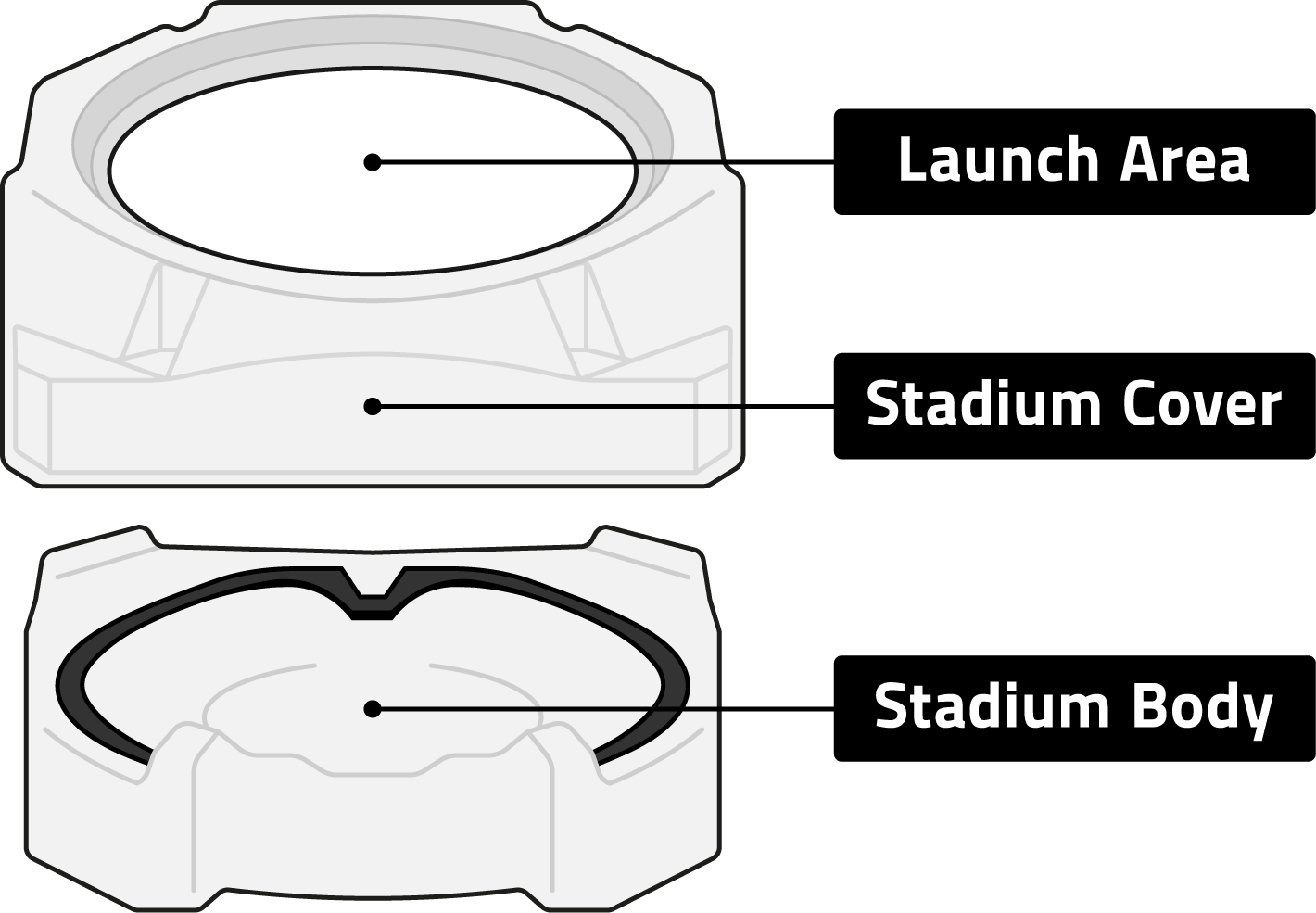
Fig. 2. Stadium Zones
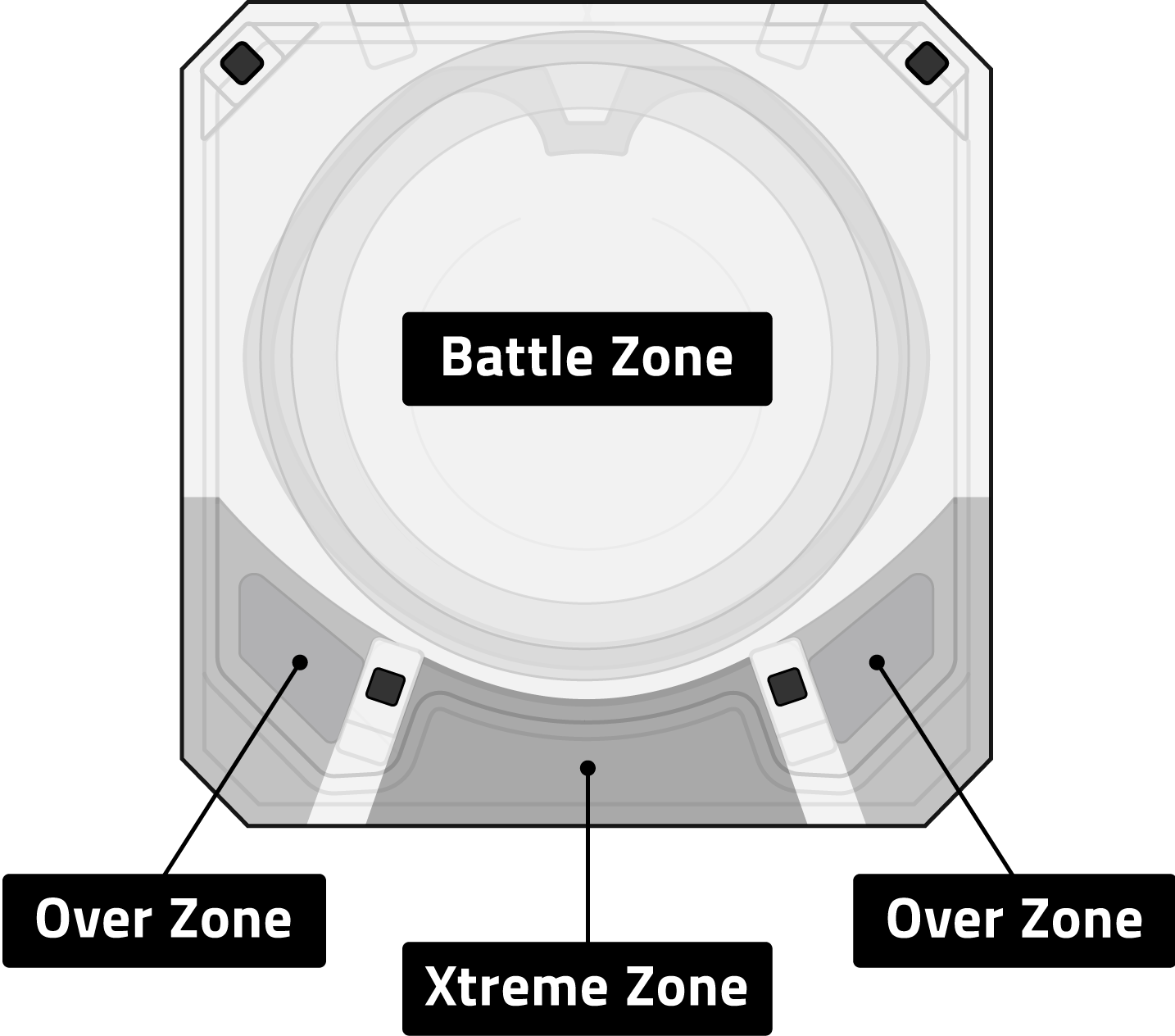
- Battles take place in the stadium.
-
The stadium is comprised of a stadium cover and stadium body (figure 1).
-
The stadium cover includes the launch area, a circular opening through which Beys are launched.
-
The stadium body is the surface Beys are launched onto.
-
The stadium cover includes the launch area, a circular opening through which Beys are launched.
-
The space inside the stadium (between the stadium cover and stadium body) is divided into three types of zones that are used during battle (figure 2):
-
the battle zone, consisting of the entire space inside the stadium except for the over zone and Xtreme zone
-
the over zone, two pockets located at the left and right corners at the front of the stadium
-
the Xtreme zone, the opening located at the front of the stadium
-
the battle zone, consisting of the entire space inside the stadium except for the over zone and Xtreme zone
- A Bey is considered to have entered a zone the moment it is mostly within that zone.
Winning a Match
- In a tournament setting, games of Beyblade are played in matches.
-
A Beyblade match consists of battles, points and sets.
-
Battles: When two Beys are played against each other and a winning Bey is determined once, resulting in points being awarded.
-
Points: Awarded to the winner of the battle. The number of points awarded is based on how the battle was won (see: scoring finishes).
-
Sets: Won when a blader has earned the required number of points.
-
Battles: When two Beys are played against each other and a winning Bey is determined once, resulting in points being awarded.
-
The points required to win a set may be 4 or 7 depending on the tournament stage.
-
4 points is required to win during the first stage of the tournament.
-
7 points is required to win during the final stage of the tournament.
-
4 points is required to win during the first stage of the tournament.
-
All matches in the Beyblade X Competitive Circuit UK are best-of-1, meaning winning one set also wins the match.
Match Phases
Starting the Match
- The match starts once both participating bladers and the judge have arrived at the designated stadium.
-
Once the match starts, you may not receive assistance or advice from others.
-
Exceptions may be made at the judge’s discretion for bladers who require assistance to play for any reason.
-
Exceptions may be made at the judge’s discretion for bladers who require assistance to play for any reason.
- Once the match starts, you may not leave the stadium except with the judge’s permission.
Launch Position
- One blader is selected to choose their launch position at either the left side or right side of the stadium.
- Before the first set of the match, the player who will choose their launch position is decided through fair, randomized means (e.g. rock-paper-scissors by both players, or a coin flip by the judge).
- Between sets during a match, the loser of the previous set chooses their launch position for the next set.
- The player who didn’t choose a launch position must take the unchosen launch position.
Bey Selection
- Both bladers reveal all Beys in their current Bey list to their opponent by showing the list and/or physically revealing the Beys.
- After each blader has reviewed their opponent's Bey list, they select the Beys in their deck in secret (typically by turning their backs to the stadium).
- Bey selection should be completed within 1 minute. Beyond 1 minute, the judge may ask you to immediately finalize your selection.
- You may never attempt to gain information about the opponent’s Bey selection during the match.
- Once a deck of Beys is selected, it is given to the judge.
- The judge will inspect each Bey to ensure compliance with equipment regulations, then return the Beys to each blader. The judge may disassemble the Beys during this process.
- Bey selection is final and cannot be changed for the match.
Bey Presentation
- Both bladers present the Bey they will use in the battle to each other by showing the top and bottom so that all parts are visible.
-
After both bladers have been presented the opponent’s Bey, both bladers may adjust their Bey.
-
When adjusting a Bey, a blader may adjust the orientation of parts in their Bey (such as rotating the position of the ratchet and/or bit), or change the mode of parts with mode change functionality, even if these adjustments require disassembly of the Bey.
-
A blader must communicate to the opponent and the judge when they are about to adjust their Bey.
-
Once the adjustment is complete and the Bey is fully assembled, the Bey is presented to the opponent again.
-
When adjusting a Bey, a blader may adjust the orientation of parts in their Bey (such as rotating the position of the ratchet and/or bit), or change the mode of parts with mode change functionality, even if these adjustments require disassembly of the Bey.
- Bladers may never touch their opponent’s Bey.
Battle
- Both bladers battle as detailed in the rules of battle section until one blader has enough points to win the set.
- If the Bey being used changes between battles (such as in a 3on3 match), do Bey presentation again before each battle.
Set Result
- If a blader has reached the required number of sets to win the the match, the judge confirms the result and the match ends.
- If neither blader has reached the required number of sets to win the match, proceed to the next set by returning to the launch position phase.
Match Type
3on3
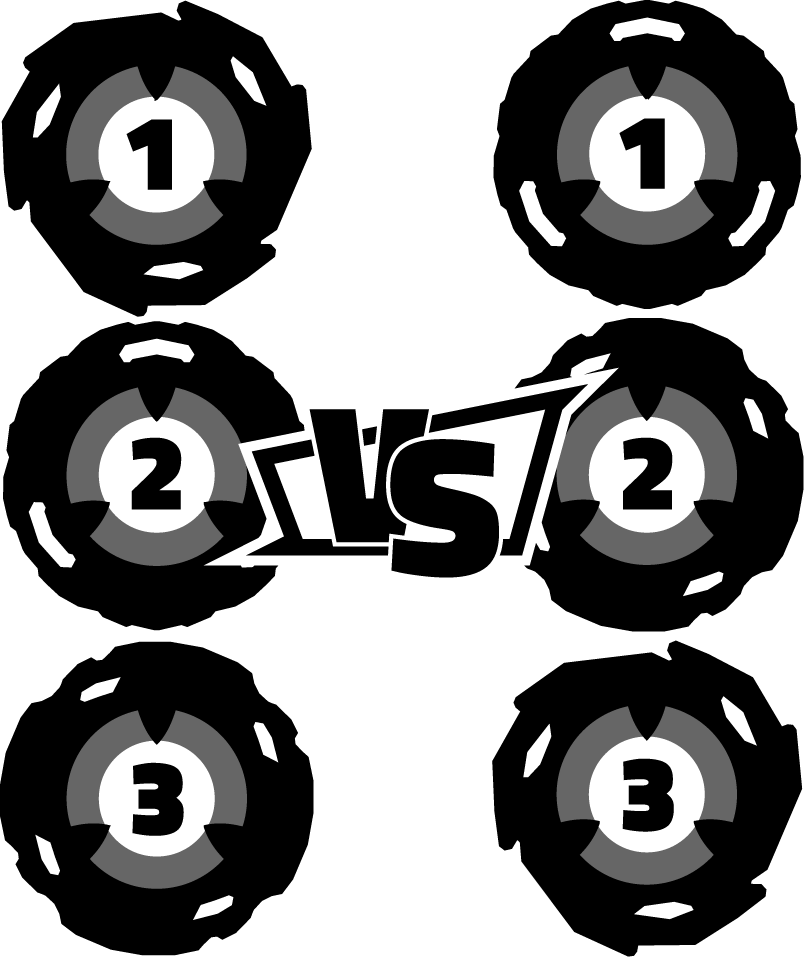
3on3
-
Bladers battle with a deck of 3 Beys, including only Beys in their submitted Bey list.
-
The deck of Beys must be stored in a way that conceals its contents and preserves the order of the Beys inside (referred to as the deck case).
-
Use of an official deck case by Takara Tomy or another deck case designed specifically for Beyblade is recommended.
- If a deck case is unavailable, use a folded sheet of paper.
-
Use of an official deck case by Takara Tomy or another deck case designed specifically for Beyblade is recommended.
-
During the Bey selection phase, Beys are arranged in the deck case in the order in which they will be used during the set, from the blader’s left to right, referred to as the 1st Bey, 2nd Bey, and 3rd Bey.
-
After each battle, bladers switch to the next Bey in their deck based on the determined order.
-
After battling with the 3rd Bey, if the set has not ended, each blader may change the order of any Beys in their deck. Then, continue the set by battling with the 1st Bey.
-
Except after battling with the 3rd Bey, the order of the deck cannot be changed during the set.
Rules of Battle
Launching
Fig. 3. Launch Area
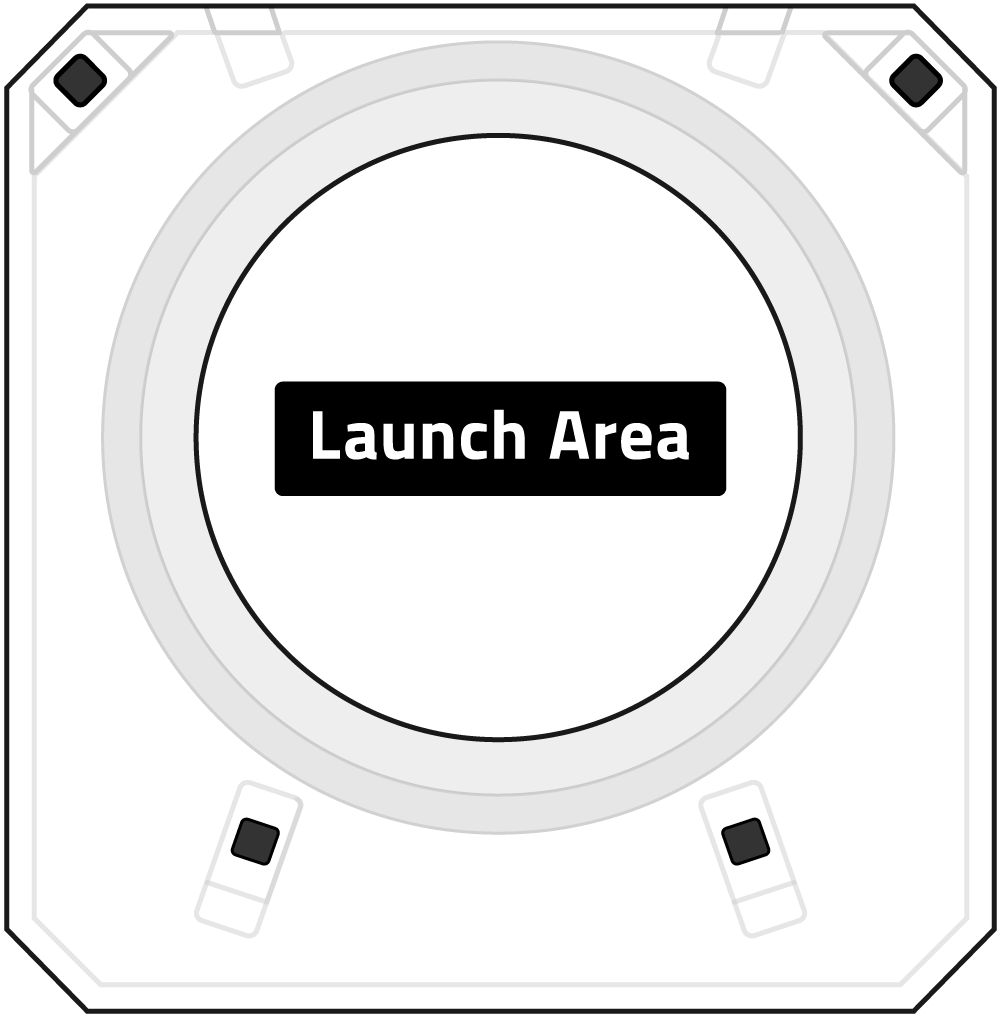
Fig. 4. Launch Height
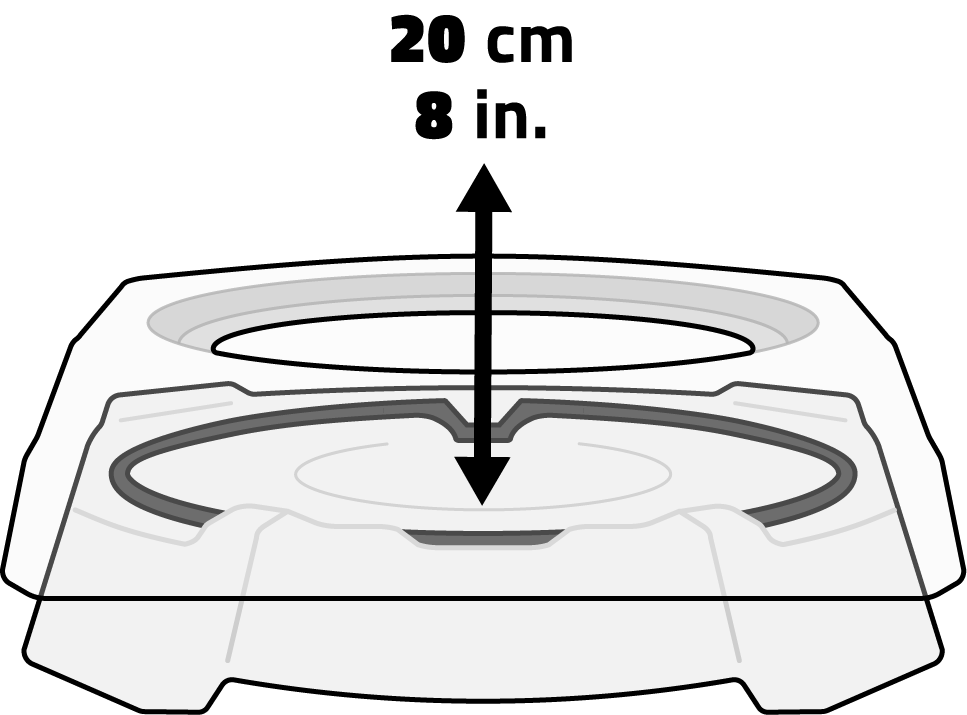
- Ensure your Bey is correctly assembled by tightening the ratchet and pressing in on the bit.
- Attach your Bey to your launcher and hold it above or within the launch area (figure 3).
- Keep the bit of your Bey facing downwards while attached to your launcher. Do not tilt your launcher so that your bit faces sideways or upwards.
- The judge will announce “ready set” to inform players that the countdown to launch is about to start. If you are not ready to launch, immediately tell the judge.
- During the countdown, the judge will call out: “three, two, one, go shoot!” or “three, two, one, let it rip!”
- Start pulling your winder/string as the word “shoot”/“rip” is called.
- Launch your Bey from within a distance of 20cm from the stadium body (figure 4).
- Do not obstruct your opponent’s launch while launching.
- Do not attempt to hit your opponent’s Bey before it touches the stadium body.
- Do not run, jump, or otherwise launch in a manner that could be unsafe.
- Do not touch or move the stadium or stadium stand while launching, including with your Bey or launcher.
- Step back immediately after launching and watch the battle. Do not lean over the stadium.
Launch errors
-
A blader commits a launch error when they:
-
begin pulling their launcher's winder/string before or after the word “shoot”/“rip” is called
-
launch from more than 20cm away from the stadium body
-
launch from an area other than directly above or within the launch area
-
launch their Bey outside the stadium
-
launch their Bey upside down or sideways
-
launch their Bey so that it touches the stadium cover before going through the launch area
-
touch any part of the stadium with their body or launcher (except for the string of a string launcher) while launching
-
begin pulling their launcher's winder/string before or after the word “shoot”/“rip” is called
- When a blader commits a launch error, the battle is voided.
-
Every time a blader commits two launch errors without either blader scoring any points, the opposing blader will receive 1 point (a penalty point).
-
If both bladers commit a launch error during the same launch, neither will be counted towards applying a penalty point.
-
If both bladers commit a launch error during the same launch, neither will be counted towards applying a penalty point.
Requesting a relaunch
-
You may request a relaunch when:
-
the opposing blader’s launch obstructed your launch
-
you were hit or otherwise obstructed by a person or object while launching
-
your launch was noticeably underpowered due to a technical issue with your launcher
-
the opposing blader’s launch obstructed your launch
- When a request for a relaunch is approved by the judge, the current battle is voided.
- Request a relaunch by saying “relaunch” immediately after launching.
-
If you requested a relaunch due to a technical issue with your launcher, and your request is approved by the judge, you must use a different launcher for the rest of the match.
-
If you do not have another launcher, you may borrow a launcher from another blader at the event if available.
-
If you do not have another launcher, you may borrow a launcher from another blader at the event if available.
- You may only request a relaunch for a technical issue once per battle.
- If you request a relaunch for a technical issue, the judge may inspect your launcher, including performing a test launch with it.
- Requests for relaunches are approved at the judge’s discretion.
- Relaunches can only be requested by the blader affected, and cannot be recommended by the opponent or the judge. For other reasons why a battle would be voided, see voided battles.
Starting and Ending Battle
- The battle starts once both Beys have touched the stadium body.
-
A Bey is considered out-of-play when it stops spinning, bursts or cannot return to the stadium.
-
Stops spinning: A Bey has stopped spinning when its rotational speed in its original spin direction becomes zero at any point in time.
-
Bursts: A Bey has burst when any part of the Bey detaches and fully separates. This includes if an individual component of one part (e.g. a blade’s lock chip) separates from the Bey.
-
Cannot return the stadium: A Bey cannot return to stadium when it is no longer within the stadium and the judge determines it is physically impossible for it to return.
-
Stops spinning: A Bey has stopped spinning when its rotational speed in its original spin direction becomes zero at any point in time.
-
The battle ends as soon as:
-
only one Bey is spinning in the battle zone while the other is out-of-play, OR
-
when all Beys are out-of-play.
-
only one Bey is spinning in the battle zone while the other is out-of-play, OR
- Do not touch the stadium or your Bey until the battle result has been confirmed by the judge. If you do, the judge may determine that you immediately lose the set.
Scoring Finishes
-
When the battle ends, the Bey that scored a finish is the winner of the battle, and the winning blader is awarded points based on the type of finish scored.
Xtreme Finish — 3 points
- Initiated when the opposing Bey enters the Xtreme zone.
- Scored when the opposing Bey becomes out-of-play.
Over Finish — 2 points
- Initiated when the opposing Bey enters the over zone.
- Scored when the opposing Bey becomes out-of-play.
Burst Finish — 2 points
- Initiated and scored when the opposing Bey bursts.
Spin Finish — 1 point
- Initiated and scored when the opposing Bey stops spinning.
Own Finish — 1 point
- Replaces an Xtreme finish or over finish if the battle ended without the Beys touching each other.
Out-of-Bounds Spin Finish — 1 point
- Initiated when the opposing Bey exits the stadium through the launch area.
- Scored when the opposing Bey becomes out-of-play.
- You initiate a finish when the opposing Bey leaves the battle zone or becomes out-of-play while in the battle zone, but you cannot win until that finish is scored.
- If you initiate an Xtreme finish or over finish, but the opposing Bey returns to the battle zone, the finish is reversed. When a finish is reversed, that finish is considered to have never been initiated and does not score.
- If both Beys score a finish, the winner is the Bey that initiated its finish first, regardless of when either finish was scored.
- If both Beys initiate a finish at the same time and both of those finishes score, the battle is a draw.
- If no Beys score a finish, the battle is a draw.
Voided and Replayed Battles
- When a battle is voided, the result of the battle is canceled, and the battle is replayed.
-
The battle will be voided if:
-
The battle is a draw
-
A launch error occurred
-
The Beys touch each other before both Beys have touched the stadium body
-
A Bey bursts before it touches the stadium body
-
A Bey exited the battle zone without passing through the Xtreme zone, over zone, or launch area, and touched any surface or object other than the stadium
-
The judge determines that a player’s launch has been obstructed
-
A blader requests a relaunch and it is approved by the judge
-
A Bey’s part broke during battle
-
The stadium breaks or part of the stadium detaches during the battle
-
The judge otherwise determines that the fair and safe play of the battle has been interfered with
-
The battle is a draw
- When a battle is replayed, bladers play the same battle again with the same launcher and Bey, unless another rule requires equipment to be changed (such as if a part or launcher breaks).
- Before a replay, Beys cannot be disassembled for adjustment; however, bits can be rotated and ratchets should be tightened.
- If part of your Bey breaks during battle, the battle is voided, and you must replace the broken part with a copy of the same part that complies with equipment regulations in order to replay the battle. If you cannot, both bladers return to the Bey selection phase and continue the match while retaining their current scores.
Regarding Judge Decisions
- If you have a concern about the battle, you must tell the judge immediately.
- Once the next battle starts, the result of the previous battle cannot be adjusted.
- If a battle was recorded on video, the judge may choose to review video footage to assist in reaching a decision.
- Some events may have a head judge and may allow you to appeal a ruling to them. You can ask the judge or the tournament organizer if this option is available.
- The final decision of the battle and/or match result belongs to the judge(s).
- You must accept the judge’s final decision. Disruptive behavior as a result of disagreeing with a ruling will lead to disqualification.
Equipment Regulations
General Regulations
- Only official Beyblade X products produced by Takara Tomy and Hasbro may be used. Products from previous generations of Beyblade may not be used.
- Only the Xtreme Stadium by Takara Tomy, or the Xtreme BeyStadium by Hasbro, may be used.
- Cracked or broken equipment including Bey parts, launchers and stadiums may not be used.
- Stadiums with hairline cracks may be repaired with tape as long as the repair is applied to the underside and results in a smooth, uninterrupted, and imperceptible surface. However, stadiums with completely broken pieces or where tape provides significant structural support cannot be used.
- Use of official equipment beyond its intended design (e.g. spinning a Bey in the incorrect spin direction) is forbidden.
- Any modification of equipment beyond what is explicitly allowed in these regulations is forbidden.
-
Parts (including Beys and launchers) may not be intentionally modified to perform beyond their original specifications, even if those modifications are otherwise permitted by the equipment regulations.
-
Original specifications means the level of performance expected from a new retail product.
-
Original specifications means the level of performance expected from a new retail product.
-
Parts made up of individual components that can be non-destructively replaced may have their components replaced with an identical substitute from another part.
-
An identical substitute is considered to be another copy of the same component with the same intended design and function.
-
The components of the part must be disassembled in a non-destructive manner and reassembled to match its original specifications.
-
The components of the part itself may not be modified in any way.
-
An identical substitute is considered to be another copy of the same component with the same intended design and function.
- Any modifications that may cause damage to a Bey or stadium (including cosmetic damage), or create an unfair advantage in battle, are forbidden even if those modifications are otherwise permitted by the equipment regulations.
Bey Regulations
-
Blades, ratchets, and bits cannot be painted except with small markings (lines or dots). Marks can be placed:
-
On a blade: Anywhere besides the blade’s contact points, or where the Ratchet makes contact with the blade’s underside.
-
On a ratchet: Anywhere on the ratchet base (the bottom part of the ratchet) besides where the bit makes contact with it.
-
On a bit: The top surface and inside of the bit’s shaft.
-
On a blade: Anywhere besides the blade’s contact points, or where the Ratchet makes contact with the blade’s underside.
-
Parts that have been worn down outside of normal play cannot be used.
-
Normal play is considered to be battling in an official stadium with a maximum of 2 other Beys.
-
Parts that have been worn or damaged through contact with surfaces or objects other than a Bey or official stadium cannot be used.
-
Normal play is considered to be battling in an official stadium with a maximum of 2 other Beys.
-
Parts that have extreme wear cannot be used, even if worn through normal play.
-
Extreme wear includes when a part’s shape or performance have dramatically changed from its original specifications, e.g. a sharp tip becoming completely flattened, or a flat tip becoming round or sharpened.
-
Rubber parts typically wear down at an accelerated rate compared to other materials. Rubber materials will not be considered extremely worn or damaged as long as the majority of rubber is intact and the wear is consistent with normal play.
-
Extreme wear is determined at the judge’s discretion.
-
Extreme wear includes when a part’s shape or performance have dramatically changed from its original specifications, e.g. a sharp tip becoming completely flattened, or a flat tip becoming round or sharpened.
- Parts which perform differently from their original specifications due to a manufacturing defect (such as a bit manufactured with the incorrect level of burst resistance) cannot be used.
Launcher Regulations
-
Any type of winder may be used with any type of winder launcher.
-
Winders: Winder, Long Winder, Entry Winder and Dragon Winder
-
Winder launchers: Winder Launcher, Entry Launcher, Winder Launcher L, and Hold Launcher
-
Winders: Winder, Long Winder, Entry Winder and Dragon Winder
- Winders cannot be modified in any way.
-
Launchers, launcher grips, and accessories may be decorated with paint and stickers.
-
Applied paint or stickers may not affect performance.
-
Designs must not contain any offensive or inappropriate imagery.
-
Applied paint or stickers may not affect performance.
- Launchers and launcher grips may have unofficial parts or accessories attached, provided they do not obstruct the opponent’s launch or modify the launcher’s performance.
Banned Parts
Bits
-
Metal Needle (MN)
-
Reason: This bit frequently damages stadiums with its pointed metal tip.
-
Reason: This bit frequently damages stadiums with its pointed metal tip.
Disqualification
- At the discretion of the tournament organizer and judge(s), you may be disqualified from an event for any reason, including but not limited to if:
- You intentionally break any rules in this ruleset
- Your equipment does not comply with the equipment regulations
- You commit an excessive number of launch errors or launch in an unsafe manner
- You behave in a rude, unsportsmanlike, or otherwise disruptive manner
- If you are disqualified during a match, you will lose the match. The results of previous rounds will not be modified.
- If you are disqualified from an event, you forfeit any placement and prizing.
- If you are disqualified from an event, you may be suspended or banned from attending future events.